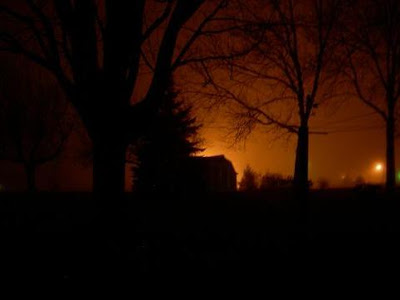
Not Seeing the Trees for the Cavities...

I'm early. Not knowing just how long it would take me to get to my meeting in Brooklyn and having a horror of being late, I'm not only early, I'm very early. There is more than an hour to do something with.
I read the plaque on the front of "The Friend's Field House" where the meeting is taking place. Which according to the city park's department sign was an athletic field owned by the Quakers early in the last century. In the early 70's it was bought by the city from The Society of Friends and there is now a modern little kid's playground, and a small tennis court that is currently being refurbished that were no doubt added by the city. When the baseball field with it's wooden bleachers arrived I've no idea but the little field house with it's cathedral ceiling, hardwood floors, and dandy working fireplace was constructed in 1937.
Yet there is something about the whole place that has the feel of an even earlier time. Why I'm not sure. But it is the case, even with all the playground equipment so heavily leaning toward brightly colored plastic.
Maybe it's the grounds, all that space, without statuary, geegaws, or little black fences to keep folks off the grass. And perhaps the trees, wait a minute--after doing all that searching for the woodpecker, I'm currently fascinated by cavities. And there's one right there, in which there seems to be a bit of feather or hair hooked on the edge. Maybe if I'm closer I'll be able to tell just what that is.


I read the plaque on the front of "The Friend's Field House" where the meeting is taking place. Which according to the city park's department sign was an athletic field owned by the Quakers early in the last century. In the early 70's it was bought by the city from The Society of Friends and there is now a modern little kid's playground, and a small tennis court that is currently being refurbished that were no doubt added by the city. When the baseball field with it's wooden bleachers arrived I've no idea but the little field house with it's cathedral ceiling, hardwood floors, and dandy working fireplace was constructed in 1937.
Yet there is something about the whole place that has the feel of an even earlier time. Why I'm not sure. But it is the case, even with all the playground equipment so heavily leaning toward brightly colored plastic.
Maybe it's the grounds, all that space, without statuary, geegaws, or little black fences to keep folks off the grass. And perhaps the trees, wait a minute--after doing all that searching for the woodpecker, I'm currently fascinated by cavities. And there's one right there, in which there seems to be a bit of feather or hair hooked on the edge. Maybe if I'm closer I'll be able to tell just what that is.

In less than a minute, the time it took to get a few steps closer, there, instead of a cavity opening, was a Gray Squirrel bottom. And a very healthy sleek squirrel bottom at that. In fact now that I look around there are squirrels everywhere. Shiny healthy fit squirrels that have very bright eyes and lush bushy tails. In a little grassed area near the building perhaps 15 feet by 15 there are 7 of them. They're everywhere. Bounding across branches, hopping through holes, running after each other in a maze of squirrel activity. Why do they look so well?
Looking at the ground, there are spots that are literally still covered with acorns, and it's January, high time they should all be stashed in the ground or in caches. Even with this many squirrels there just aren't enough hours in the day to get them all taken care of. Amazing.
So this is what this animal looks like when it is eating the food it evolved to eat. And if you have this many acorns...

I look up, open my eyes, and finally see all the trees. And these aren't just run of the mill city trees. No London Planes these, but rather mighty mature Oak Trees.
Trees that sink deep, rise high, and have for years. These are trees with girth.
Slow growers are oaks. So it's girth, the niggle at the edge of consciousness that made this patch seem like territory misplaced in time.
Wait, not just seem from another time but actually to be from another time as they are many and they are big. Not something one sees in New York City very often, an actual grove of old oaks surrounding acres of space.
Was it the Friends who planted them? Perhaps some, but others are older, old enough to have been here, well, before.
It's not Muir Woods, but still they're--before.
They are a pleasure, looking up gives me a tingle down my spine. But why? Could it be that there is something that evolved in our DNA like that of the squirrels that makes for human well being as well?
Or is it as the Celts believed? Simply, that a grove of oaks is magic.
Donegal Browne














































